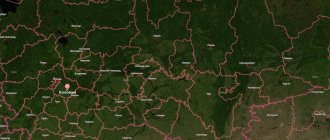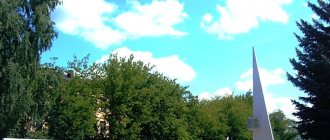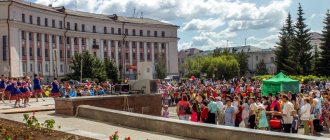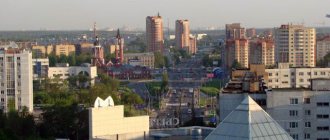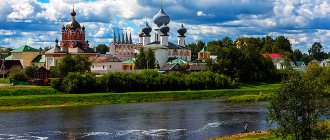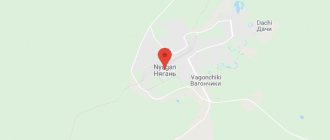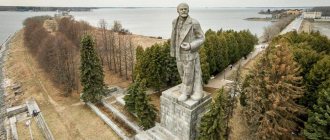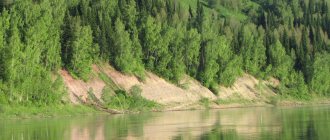For the first time we read about the city of Balakhna in a chronicle in 1536: after the attack of the Kazan Khan Safa-Girey on the salt workers’ village, the settlement was protected by a wood-earth fortress. It is unknown what source the learned compilers of the “Encyclopedic Dictionary of Brockhaus and Efron” used at the end of the 19th century, designating the year of Balakhna’s birth as 1474—then the exiled Novgorodians found the Balakhna Usolye.
Salt replenished the reserves of the royal treasury; serving people received their salaries with salt. Balakhna was engaged in salt production until the beginning of the 19th century.
Peter I had high hopes for the Balakhna shipyards. At the beginning of the 18th century, Balakhna was the main center of shipbuilding on the Volga. A century later, the history of the production of steamships, and later motor ships, began. And at the beginning of the 20th century, the last wooden barge was built in Balakhna.
Another craft of the Balakhna woodcarving masters - the art of making tiles - has also sunk into oblivion. And once upon a time, wooden forms for decorating Moscow itself were ordered from Balakhna.
For 200 years, Balakhna delighted with its airy lace; now only a few craftswomen keep the secrets.
The formation of modern industry began with the construction of the Nizhny Novgorod State District Power Plant, a pulp and paper mill and a cardboard factory.
The names of rare masters of the past have been preserved by time, but one name of a local native, awarded with organizational talent, is still glorified by the Russian people today - Kuzma Minin, a man with a king in his head.
Routes on the map of Balakhna. Transport infrastructure
Railways
Balakhna is connected with Nizhny Novgorod and the Volga region.
Balakhna railway is located at st. Engelsa, 109.
Car roads
- Motor transport is the basis of passenger transportation in the city and region.
- Local buses: 2, 6, 7, 11, 12, 14, 51, 57, 102, 104, 105, 106, 107, 108, 109, 110, 112, 125.
- Minibuses: 7a, 17.
- Balakhna bus station - st. Dzerzhinsky, 30.
- highway R-152 goes through Balakhna .
- There is bus 203A to Nizhny Novgorod and bus 203 back.
Volzhskaya transport highway
The movement of motor ships, "Rockets" and "Meteors", as well as heavy-duty barges to the cargo pier is open.
There is no river station in the city.
Content
- 1. History
- 2 Population
- 3 Administrative and municipal structure 3.1 Settlements
- 4.1 Socio-economic development
- 4.5.1 Land resources
Sights of the city of Balakhna
- Balakhna Museum of Local Lore;
- estate of the merchant Khudyakov, historical and cultural center;
- house of merchant Alexandrov, children's museum "Solonitsa";
- modern sports and fitness center;
- cultural and leisure;
- Church of the Nativity of Christ, Sretenskaya, Pokrovskaya, Spasskaya and the oldest St. Nicholas churches;
- Zoo "Little Country", a branch of the Nizhny Novgorod Zoo "Limpopo".
The city maintains a hotel for guests.
All attractions are marked on the map of Balakhna with houses.
Population
| Population | ||||||||
| 1939[8] | 1959[9] | 1970[10] | 1979[11] | 1989[12] | 2002[13] | 2008[14] | 2009[14] | 2010[13] |
| 84 907 | ↘36 307 | ↘9241 | ↗59 264 | ↗60 487 | ↗83 683 | ↘79 468 | ↘78 592 | ↘77 598 |
| 2011[14] | 2012[15] | 2013[16] | 2014[17] | 2015[18] | 2016[19] | 2017[20] | 2018[21] | 2019[22] |
| ↘77 416 | ↘76 888 | ↗76 953 | ↘76 826 | ↗76 949 | ↘76 907 | ↘76 612 | ↘76 266 | ↘75 851 |
| 2020[4] | ||||||||
| ↘75 698 | ||||||||
Urbanization
92.09% of the district's population live in urban areas (the city of Balakhna, the workers' settlements of Bolshoye Kozino, Gidrotorf, Maloye Kozino, Lukino, Pervoe Maya).
Sport
There are 3 stadiums and 24 gyms. In 2009 on the street. The Olimpiyskiy sports and recreation complex with a swimming pool and ice arena opened on Olimpiyskaya Street. There are also indoor swimming pools in the sports complex of the Volga JSC enterprise (Pravdinsk microdistrict) and (Bolshoye Kozino village).
As of 2015, 37 sports are being developed in the Balakhninsky district (football, hockey, basketball, rhythmic gymnastics, boxing, sports tourism, kickboxing, track and field and weightlifting, powerlifting, sambo, judo, volleyball, table tennis, darts, arm wrestling, streetball, figure skating, cross-country skiing, swimming, sports dancing, bandy, etc.)
Administrative and municipal structure
The Balakhninsky district, within the administrative-territorial structure of the region, includes 7 administrative-territorial entities, including 1 city of regional significance, 3 workers’ villages (one of which has 2 more workers’ villages subordinated to it) and 3 village councils[23][24][ 25].
The Balakhninsky municipal district, within the framework of the organization of local self-government, included, respectively, 7 municipalities, including 4 urban settlements and 3 rural settlements[26].
| № | Administrative-territorial (municipal) entity | Administrative center | Number of settlements | Population (persons) | Area (km²) |
| 1 | Balakhna city | Balakhna city | 1 | ↘48 520[4] | 70,63[3] |
| 2 | working village of Bolshoye Kozino | working village of Bolshoye Kozino | 5 | ↗7544[4] | 96,30[3] |
| 3 | working village Gidrotorf | working village Gidrotorf | 12 | ↘7786[4] | 118,11[3] |
| 4 | working village of Maloye Kozino | working village of Lukino | 3 | ↘6934[4] | 126,00[3] |
| 5 | Konevsky village council | Konevo village | 7 | ↘946[4] | 321,11[3] |
| 6 | Kocherginsky village council | Trestyany village | 14 | ↗3373[4] | 90,41[3] |
| 7 | Shelyaukhovsky village council | Shelyaukhovo village | 4 | ↗595[4] | 74,03[3] |
Initially, on the territory of the Balakhninsky district until 2009, 4 workers’ settlements and 4 village councils were allocated. As part of the organization of local self-government in 2006-2009. 4 urban and 4 rural settlements were formed, respectively.
In 2009, the Zamyatinsky village council was abolished and reassigned to the workers' settlement (the workers' settlement of Gidrotorf was included in the urban settlement)[27].
Settlements
There are 46 settlements in the Balakhninsky district.
| List of settlements in the region | ||||
| № | Locality | Type | Population | Administrative-territorial (municipal) entity |
| 1 | Alferovo | village | ↗5[13] | working village Gidrotorf |
| 2 | Indian | village | ↗18[13] | working village Gidrotorf |
| 3 | Balakhna | city | ↘48 520[4] | Balakhna city |
| 4 | Belovskaya | village | →30[13] | Kocherginsky village council |
| 5 | Bolshiye Mogiltsy | village | ↗119[13] | Kocherginsky village council |
| 6 | Bolshoye Kozino | workers' village | ↗6897[4] | working village of Bolshoye Kozino |
| 7 | Bredovo | village | ↘6[13] | Konevsky village council |
| 8 | Burtsevo | village | ↘50[13] | Konevsky village council |
| 9 | Vatagino | village | ↘10[13] | working village Gidrotorf |
| 10 | Galkino | village | ↗26[13] | Shelyaukhovsky village council |
| 11 | Hydropeat | workers' village | ↘7362[4] | working village Gidrotorf |
| 12 | Gridenino | village | ↗36[13] | working village Gidrotorf |
| 13 | Gumnishchi | village | ↘134[13] | Shelyaukhovsky village council |
| 14 | Zamyatino | village | ↘162[13] | working village Gidrotorf |
| 15 | Istomino | village | ↗1378[13] | Kocherginsky village council |
| 16 | Kadanovo | village | ↘38[13] | working village Gidrotorf |
| 17 | Konevo | village | ↘1016[13] | Konevsky village council |
| 18 | Korobeynikovo | village | ↗24[13] | Kocherginsky village council |
| 19 | Kostenevo | village | ↘193[13] | working village of Bolshoye Kozino |
| 20 | Kochergino | village | ↗76[13] | Kocherginsky village council |
| 21 | Lipovki | village | →90[13] | Kocherginsky village council |
| 22 | Lipovki | railway village patrol | ↗57[13] | Kocherginsky village council |
| 23 | Lukino | workers' village | ↘3874[4] | working village of Maloye Kozino |
| 24 | Lyapunikha | village | ↘115[13] | Kocherginsky village council |
| 25 | Lyakhovo | village | ↘200[13] | working village of Bolshoye Kozino |
| 26 | Lyakhovsky Borok | village | ↘13[13] | working village of Bolshoye Kozino |
| 27 | Malinino | village | ↘9[13] | Konevsky village council |
| 28 | Maloe Kozino | workers' village | ↘889[4] | working village of Maloye Kozino |
| 29 | Malye Mogiltsy | village | ↘180[13] | Kocherginsky village council |
| 30 | May Day | workers' village | ↘2171[4] | working village of Maloye Kozino |
| 31 | May Day | village | ↘19[13] | working village of Bolshoye Kozino |
| 32 | Pogarnovo | village | ↘4[13] | Konevsky village council |
| 33 | Postnikovo | village | ↗256[13] | Kocherginsky village council |
| 34 | Rylovo | village | ↘186[13] | working village Gidrotorf |
| 35 | Smirino | village | ↘219[13] | Shelyaukhovsky village council |
| 36 | State Farm | village | ↘864[13] | Kocherginsky village council |
| 37 | Sonino | village | ↗11[13] | Konevsky village council |
| 38 | Trestyany | village | ↗215[13] | Kocherginsky village council |
| 39 | Tychinino | village | →3[13] | working village Gidrotorf |
| 40 | Black | village | ↘25[13] | Kocherginsky village council |
| 41 | Churkino | village | ↘3[13] | working village Gidrotorf |
| 42 | Shalimovo | village | ↗14[13] | working village Gidrotorf |
| 43 | Shelyaukhovo | village | ↘314[13] | Shelyaukhovsky village council |
| 44 | Shishkino | village | ↗69[13] | Kocherginsky village council |
| 45 | Yurino | village | ↘3[13] | Konevsky village council |
| 46 | Yasnevo | village | ↗3[13] | working village Gidrotorf |
Abolished settlements
In 1993, the town of Pravdinsk was included in the city of Balakhna.
Culture
The network of cultural institutions in the district includes the Balakhninsky Museum Historical and Art Complex, 14 cultural centers, and 21 libraries. The Balakhna Museum Historical and Art Complex consists of 4 branches: “Plotnikov House”, “Khudyakov Estate”, “Kuzma Minin Museum”, “Black Swan” Glass Museum. Each museum has its own specifics and areas of work. “Plotnikov House” (former merchant mansion of the merchant-shipbuilder Plotnikov) is a historical museum that generally represents the history of the area since ancient times. Particular attention is paid to crafts: salt making, brick, tile, glass, bell foundry, etc. In the “Plotnikov House” there is a lace-making workshop - a traditional craft for Balakhna since the 18th-19th centuries. The museum also contains a unique collection of restored icons found in ancient and destroyed churches in the city of Balakhna and which are shrines and masterpieces of art that have been prayed for over the years. “Khudyakov’s Estate” is an entire estate complex with a park area, an object of cultural heritage of regional significance, where merchant and bourgeois life is mostly shown. The estate specializes in holding folklore events. There are also workshops for making clay Zhbannikov whistles and wood carvings. “Museum of Kuzma Minin” (the only Minin museum in Russia), located in the cultural center, has a thematic focus. The museum presents an updated exhibition dedicated to Kuzma Minin, the events of the Time of Troubles and the creation of the Nizhny Novgorod militia. The Black Swan Glass Museum is located in the house of the glass factory manager Adrian Davydovich Deryugin in the village of Konevo (the museum was opened on August 20, 2021 for the 400th anniversary of the village). The historical building contains about 300 exhibits - from the Neolithic era to the present. The office of the pre-revolutionary owners of the Lebedev plant has been recreated, and copies of scribe books are presented. But the most important thing is that the museum displays dishes and souvenirs made in Soviet times by the hands of modern Konevo residents.
On May 21, Balakhna residents celebrate the day of remembrance of their fellow countryman Kozma Minin. On this day, a rally “To Citizen Minin - Grateful Posterity” is held on Sovetskaya Square near the monument to Minin.
Economy of the region
Socio-economic development
At the end of 2015, the Balakhninsky district took 5th place in the ranking among 52 territories of the Nizhny Novgorod region in terms of socio-economic development (2014 - 14th place).
The average monthly salary in the region is 23,098.75 rubles.
Industry
The basis of the region’s economy is industry, represented by enterprises in the following sectors:
- pulp and paper and woodworking - 90.5% (due to the Volga paper mill - 84.2%);
- mechanical engineering and metalworking - 3.3%;
- glass - 1.2%;
- chemical - 0.1%;
- light - 0.1%;
- food - 2.3%;
- mixed feed - 2.5%.
There are 13 large and medium-sized enterprises operating in the district, including two production facilities of Russian significance. JSC "PZRA" is a large industrial complex, including numerous types of production and JSC "Volga" - the largest producer of newsprint, 75 percent of its products are exported, among the main buyers are Germany, Great Britain, France, and Turkey.
Industrial enterprises
- JSC "Volga"
- OJSC “Research and Production Association “Pravdinsky Radio Plant””[28];
- JSC "Uzola"
- PKF "Luidor"
- LLC "Biaksplen"
- JSC "Polygraphkarton"
- Furniture factory "Olmeko"
- JSC "FormMat"
- CJSC Ruskomtrans
- LLC CNT "Real-Invest"
- CJSC "Balahninskoye Glass"
- JSC "Polymertech"
- LLC "Research and Production Association "Agrostroyservis"
- LLC "Rettenmaier RUS Production"
- LLC "Center for New Technologies - Spectrum"
Agriculture
The main focus of the district's agriculture is crop production and livestock farming, focused on growing grain, potatoes, fodder crops, producing feed, growing and processing meat and milk. There are three farms, a meat processing plant and a bakery in the area.
- LLC "Istok"
- LLC "Pravdinskoye"
- IP Gyuliev Nasib Gurban ogly
- PJSC Balakhninsky Bread Factory
- Balakhninsky Meat Processing Plant LLC
Transport
Transport connections of the Balakhninsky district are carried out via the Nizhny Novgorod - Zavolzhye railway (35 km from Nizhny Novgorod to Balakhna), which was the first electrified railway in the region and road traffic. The length of road route lines, including intra-regional ones, is 495 km.
Resources
Land resources
In rural areas, 13.2% of land is agricultural land (of which 37.2% is arable land, 20.4% is pasture and 17.7% is hayfields). About 67% of the region's land is forested.
The soil cover is dominated by soddy-slightly podzolic sandy and sandy loam soils. Peat-bog soils are widespread.
The region's lands have a significant fund for expanding agricultural land. The most promising lands for plowing are lowland peatlands, river floodplains and watershed uplands. Their involvement in agricultural production is associated with large-scale reclamation work.
Forest resources
In the oak grove between Balakhna and Pravdinsk
The total forest area of the Balakhninsky district is more than 51,000 hectares (1.5% of the forest area of the region), of which 40,500 hectares are covered with forest.
The share of coniferous trees in the forests of the Balakhninsky district accounts for more than 60% of the forested area, the share of soft-leaved trees - 39%, and hard-leaved trees - about 1%. In terms of age, the forests of the Balakhninsky district are dominated by middle-aged forests - 65% of the forested area, young forests - 32%, ripening forests - 2%, mature and overmature forests - 1% of the forested area.
Mineral resources
Among the mineral resources, it should be noted the presence of large reserves of construction sands (more than 10,000,000 m³), deposits of molding sands, and peat. Local peat deposits have long been used in the area, since 1925 it has become the basis of industrialization. Using these reserves, the region's industry began to develop.
Water resources
The basis of the water resources of the region is formed by the largest water artery of the country - the Volga River, along which a wide floodplain stretches. There are many lakes and oxbow lakes rich in fish on the floodplain. Among the large lakes is Borovskoye, with an area of 49 hectares, located 9 km southwest of the village of Lukino, Balakhninsky district. The average depth is 1.6 m. It is surrounded by a swamp where rare plant species grow, including those listed in the Red Book of the Russian Federation.
Natural monuments
- Lake Borovskoe.
- The swamp along the Chernaya and Proyma rivers is a typical lowland transitional swamp, covering an area of about 800 hectares. It is an excellent cranberry.
- The Semirechye swamp has an area of 573 hectares; on its territory many species of valuable plants have been preserved and taken under state protection.
Churches
- Sretenskaya Church
The Presentation Church (1807) stands on the left bank of the Zheleznitsa River and is located in the village of Kubentsevo, which only recently became part of the city. It faces the road with its eastern altar façade. This cubic building is completed with triangular pediments on all four facades, with chapters mounted on the ridges of the eight-pitched roof. In the composition of the complicated five-domed structure, in the treatment of the walls, the shape of the windows of the church, as well as the top of the gate, vestiges of the Baroque of the mid-18th century are still felt. Small decorative drums support bulbous heads so wide that they barely fit above the roof of the building. The cornices of the pediments with crackers and other elements of classical profile are hewn out of brick, and modular and other details characteristic of the architecture of classicism are also made, which during this period were usually made of plaster and plaster casts. At the same time, there are signs of a transition to a new, more strict nature of architecture, according to which order forms are applied more consistently. The simple capitals of the pilasters, like all the details of the cornice, are carefully hewn from brick. Unfortunately, now, under thick layers of plaster and many layers of paint, their structural basis is almost invisible. This evidence of a realistic understanding of the connection between form and structure, still alive in those years among the Balakhna masons, does not reach the viewer now. A tall three-tier bell tower, built in the same style, complements the ensemble with its slender volume, surrounded by a fence with a stone gate of a clearly Baroque silhouette.
- Church of the Nativity
Not far from the Intercession Monastery you can see the heads of another 17th century monument—the Church of the Nativity of Christ. In the XVI-XVII centuries. on this site was the Nativity Convent, abolished in 1764. It is known that in 1618 there was a wooden tent church in the monastery. The hundredth charter of Balakhna in 1674 speaks of a stone monastery church, which had not yet been consecrated. Obviously, its discovery, which was completely ready at the time the inventory was compiled, took place no later than the following year, 1675. The style and nature of the execution of the cornices, window frames and other profiled brick parts are fully consistent with this date. The Church of the Nativity of Christ is built in the form of a clear cubic volume. Its walls are traditionally divided into three parts by blades, each of which ends with a zakomara. On the smooth planes of the white walls, the windows and their frames take up little space. The simple cylindrical drums end in five helmet-shaped domes covered with shiny green tiles with archaic crosses, similar to the examples of the 15th-16th centuries. The squat altar apses emphasize the height of the walls and the geometric regularity of the edges of the main volume. On three sides the church was surrounded by a one-story gallery, later turned into a closed porch. Cubic low aisles were attached to the church from the north and south. They each have one chapter, the transition to which was served by stepped tiers of kokoshniks, now hidden under an iron roof. Above the southwestern corner of the gallery stood a bell tower, which was later dismantled. Despite its relatively small size, the simple contours of the Church of the Nativity give the impression of calm grandeur, which is greatly facilitated by the contrast of its main volume with the plastically more developed, but small chapels. Both in the church and in the chapels, iconostases from the 18th century, decorated with characteristic Baroque carvings, have been preserved.
- Trinity Church
The architecture of the Trinity Cemetery Church, built in 1784, is also not typical for this time and rather resembles the forms of the early 18th century.
The church has the appearance of an octagonal tower based on a quadrangle, divided into two tiers of equal width and covered with a dome with a decorative dome. Adjacent to the church from the west is the refectory, which has a modestly crafted entrance at the end. The bell tower, which no longer exists, stood separately and also had the shape of an octagonal tower, similar in size and volume to the church. The church was built with great skill. A subtle understanding of the architectural plasticity of the wall is expressed here, for example, in the fact that the details of the window frames of the upper tier of the octagon, with a similar design, have a smaller relief than similar details of the lower tier. The brick gate leading to the Trinity Church is very colorful, with its small dome and tiled covering. Balakhna is a city founded in 1474. Along with Arzamas and Gorodets, it has the status of a historical city of the Russian Federation.
